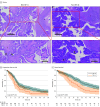Tumor-Stroma Proportion to Predict Chemoresistance in Patients With Ovarian Cancer
- PMID: 38411963
- PMCID: PMC10900967
- DOI: 10.1001/jamanetworkopen.2024.0407
Tumor-Stroma Proportion to Predict Chemoresistance in Patients With Ovarian Cancer
Abstract
Importance: Platinum-based chemotherapy is the backbone of standard-of-care treatment for patients with advanced-stage, high-grade serous carcinoma (HGSC), the most common form of ovarian cancer; however, one-third of patients have or acquire chemoresistance toward platinum-based therapies.
Objective: To demonstrate the utility of tumor-stroma proportion (TSP) as a predictive biomarker of chemoresistance of HGSC, progression-free survival (PFS), and overall survival (OS).
Design, setting, and participants: This prognostic study leveraged tumors from patients with HGSC in The Cancer Genome Atlas (TCGA) cohort (1993-2013) and an independent cohort of resected clinical specimens from patients with HGSC (2004-2014) available in diagnostic and tissue microarray formats from the University of Tübingen in Germany. Data analysis was conducted from January 2021 to January 2024.
Exposure: Diagnosis of HGSC.
Main outcomes and measures: Principal outcome measures were the ability of TSP to predict platinum chemoresistance, PFS, and OS. Using hematoxylin and eosin-stained slides from the Tübingen cohort (used for routine diagnostic assessment from surgical specimens) as well as tissue microarrays, representative sections of tumors for scoring of TSP were identified using previously evaluated cutoffs of 50% stroma or greater (high TSP) and less than 50% stroma (low TSP). Digitized slides from the TCGA Cohort were analyzed and scored in a similar fashion. Kaplan-Meier time-to-event functions were fit to estimate PFS and OS.
Results: The study included 103 patients (mean [SD] age, 61.6 [11.1] years) from the TCGA cohort and 192 patients (mean [SD] age at diagnosis, 63.7 [11.1] years) from the Tübingen cohort. In the TCGA cohort, there was no significant association of TSP levels with chemoresistance, PFS, or OS. However, in the Tübingen cohort, high TSP was associated with significantly shorter PFS (HR, 1.586; 95% CI, 1.093-2.302; P = .02) and OS (hazard ratio [HR], 1.867; 1.249-2.789; P = .002). Patients with chemoresistant tumors were twice as likely to have high TSP as compared to patients with chemosensitive tumors (HR, 2.861; 95% CI, 1.256-6.515; P = .01). In tissue microarrays from 185 patients from the Tübingen cohort, high TSP was again associated with significantly shorter PFS (HR, 1.675; 95% CI, 1.012-2.772 P = .04) and OS (HR, 2.491; 95% CI, 1.585-3.912; P < .001).
Conclusions and relevance: In this prognostic study, TSP was a consistent and reproducible marker of clinical outcome measures of HGSC, including PFS, OS, and platinum chemoresistance. Accurate and cost-effective predictive biomarkers of platinum chemotherapy resistance are needed to identify patients most likely to benefit from standard treatments, and TSP can easily be implemented and integrated into prospective clinical trial design and adapted to identify patients who are least likely to benefit long-term from conventional platinum-based cytotoxic chemotherapy treatment at the time of initial diagnosis.
Conflict of interest statement
Figures



Similar articles
-
Clinical Significance of the Stromatic Component in Ovarian Cancer: Quantity Over Quality in Outcome Prediction.bioRxiv [Preprint]. 2023 Jun 29:2023.06.27.546712. doi: 10.1101/2023.06.27.546712. bioRxiv. 2023. PMID: 37425832 Free PMC article. Preprint.
-
Association of Somatic Mutations of ADAMTS Genes With Chemotherapy Sensitivity and Survival in High-Grade Serous Ovarian Carcinoma.JAMA Oncol. 2015 Jul;1(4):486-94. doi: 10.1001/jamaoncol.2015.1432. JAMA Oncol. 2015. PMID: 26181259 Free PMC article.
-
Deep Learning Artificial Intelligence Predicts Homologous Recombination Deficiency and Platinum Response From Histologic Slides.J Clin Oncol. 2024 Oct 20;42(30):3550-3560. doi: 10.1200/JCO.23.02641. Epub 2024 Jul 31. J Clin Oncol. 2024. PMID: 39083703 Free PMC article.
-
Salvage systemic therapy for advanced gastric and oesophago-gastric junction adenocarcinoma.Cochrane Database Syst Rev. 2020 Nov 19;11(11):CD012078. doi: 10.1002/14651858.CD012078.pub2. Cochrane Database Syst Rev. 2020. PMID: 33210731 Free PMC article.
-
Single or combined immune checkpoint inhibitors compared to first-line platinum-based chemotherapy with or without bevacizumab for people with advanced non-small cell lung cancer.Cochrane Database Syst Rev. 2020 Dec 14;12(12):CD013257. doi: 10.1002/14651858.CD013257.pub2. Cochrane Database Syst Rev. 2020. Update in: Cochrane Database Syst Rev. 2021 Apr 30;4:CD013257. doi: 10.1002/14651858.CD013257.pub3. PMID: 33316104 Free PMC article. Updated.
Cited by
-
Serous Ovarian Carcinoma: Detailed Analysis of Clinico-Pathological Characteristics as Prognostic Factors.Cancers (Basel). 2024 Oct 25;16(21):3611. doi: 10.3390/cancers16213611. Cancers (Basel). 2024. PMID: 39518051 Free PMC article.
-
Characterization of collagen profile in peritoneal metastases of colorectal cancer.Sci Rep. 2025 Jul 1;15(1):20528. doi: 10.1038/s41598-025-05604-x. Sci Rep. 2025. PMID: 40594269 Free PMC article.
-
Targeting mitochondria: a novel approach for treating platinum-resistant ovarian cancer.J Transl Med. 2024 Oct 25;22(1):968. doi: 10.1186/s12967-024-05770-y. J Transl Med. 2024. PMID: 39456101 Free PMC article. Review.
-
Stroma content in triple-negative breast cancer spheroid models regulates penetration and efficacy of tumor-targeting Salmonella typhimurium.NPJ Breast Cancer. 2025 Jun 19;11(1):56. doi: 10.1038/s41523-025-00770-7. NPJ Breast Cancer. 2025. PMID: 40537480 Free PMC article.
-
Association of High Tumor-Stroma Ratio with Prostate Cancer Progression: Insights from Clinical and Genomic Data.Int J Gen Med. 2025 May 20;18:2599-2618. doi: 10.2147/IJGM.S515066. eCollection 2025. Int J Gen Med. 2025. PMID: 40417419 Free PMC article.
References
Publication types
MeSH terms
Substances
LinkOut - more resources
Full Text Sources
Medical
Miscellaneous

